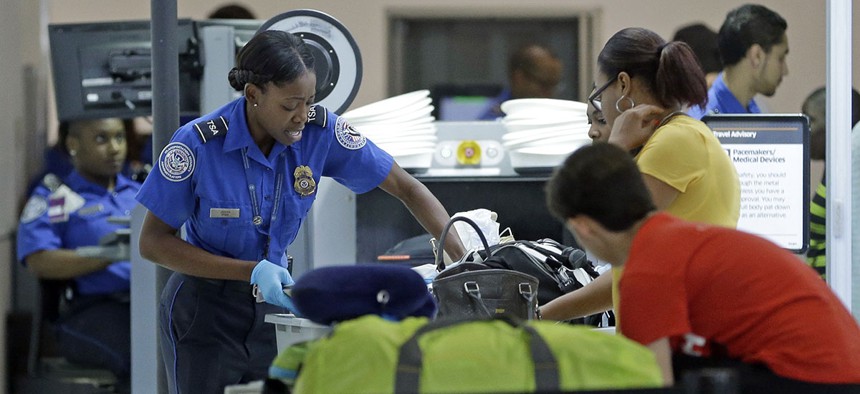TSA Wants New Scanners That Will Allow Fliers to Keep their Shoes On

A TSA officer checks travelers luggage to be screened by an x-ray machine at a checkpoint at Fort Lauderdale-Hollywood International Airport. Alan Diaz/AP
The agency also asked for proposals for a different breed of carry-on luggage screener that would use advanced computer algorithms to spot suspicious liquids and laptops.
With more travelers taking to the skies and threats continuing to evolve, the Transportation Security Administration is out with new priorities for passenger screening that involve more artificial intelligence -- and will let you keep your shoes on.
Late Tuesday afternoon, TSA asked security vendors and experts to help overhaul body-scan machines in a request for information. The agency also solicited contract proposals for a different breed of carry-on luggage screener that would use advanced computer algorithms to spot suspicious liquids and laptops. No need to remove anything from you or your bag, under these new plans.
The release of the objectives for "enhanced passenger screening" comes amid staffing shortages that have caused hours-long waits at airports nationwide, including a line so long at Chicago Midway, it took one passenger 2.5 minutes to walk its entire length.
Both new scanning technologies will rely on "open architecture" designs that allow the government to swap in new computer formulas and other tools, as needed.
"The TSA is interested in exploring technical alternatives to screen passengers for anomalies with increased detection capabilities, increased throughput, and limited false alarm rates while minimizing divestiture requirements and lifecycle costs," the May 31 request for information states.
Specifically, the goal is to deploy body-scan machines that allow the "passenger to be screened in whole," so people can "keep shoes and jackets on," TSA said. At the same time, the systems must meet a higher detection standard for explosives.
The envisioned setup would push through at least 300 passengers per hour, which is twice as fast as the current rate and equal to the speed of "PreCheck" fast lanes.
The new carry-on scanners or retrofitted, existing devices would handle at least 600 items to keep up with higher passenger speeds, according to the contract solicitation.
The body-scan machines would give operators a range of artificial intelligence "detection algorithms" to choose from, based on security levels, TSA said. No need to reboot the hardware to make the switch and you can tailor the detection strength for each individual passenger, the May 31 objectives state.
The agency is asking potential body-scan contractors to describe how their proposed systems might sync with other checkpoint technologies, like biometrics.
The smart and free fast lanes would not be available for at least another few years, if TSA keeps to its projected contracting schedule.
The agency wants to pick body-scan prototypes for testing inside a Homeland Security Department lab within 24 months, and then have them ready for operational testing at the TSA Security Integration Facility a year after that. It would be about three years before the new carry-on screeners would be tested in the field, according to the May 31 broad agency announcement solicitation.
The carry-on tech will build upon refined sensing techniques honed at the Pentagon's research wing, the Defense Advanced Research Projects Agency.
Current airport x-ray scanners "collect far more visual information than is needed because they do not effectively differentiate between the clutter and the threat," Mark Neifeld, a University of Arizona electrical and computer engineering professor who worked on DARPA's Knowledge Enhanced Compressive Measurement project, explained to the UA Engineering Research Review.
On Monday a TSA spokeswoman told Nextgov on background that there is no cost information yet for either plan yet, because the agency is still collecting input.
This is not the first time TSA has sought industry's help with scanning through shoes and coats.
In February 2014, the agency asked the private sector for prototypes that could discern weapons using X-ray vision without a TSA officer having to interpret the images.
Last month, Homeland Security obtained an additional $34 million from Congress to fast-track the hiring of 768 human TSA screeners.
TSA gridlock, meanwhile, could cost $4.3 billion June through August, as travelers rethink their plans.
NEXT STORY: Video: The Itty-Bitty Robot You Can Eat



